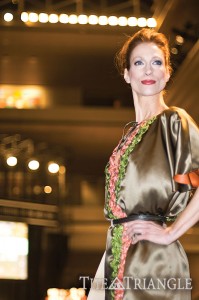Philly has gone Francophile, thanks to the first Philadelphia International Festival of the Arts. PIFA, a three-week long celebration embracing all art forms, takes inspiration from Paris in the 1910s to the 1920s. Marked by an explosion of creativity in fashion, dance, film, fine arts and more, this period holds similarities to the breadth and talent of the evolving arts community in Philadelphia.

While centered on events at the Kimmel Center, PIFA also includes exhibits and performances all over the city. The Pearlstein Gallery in Nesbitt is host to “Brave New World: Fashion and Freedom, 1911-1919.” The must-see exhibit, created by curator Clare Sauro, embraces the turning point the teens represented for fashion and the freedom of dress women were beginning to embrace. The DHCC is arguably one of Drexel’s greatest resources for its design students and was initiated with donations from illustrious members of the Drexel family, many of whom were at the forefront of fashion during this revolutionary time.
Roberta Gruber, head of the fashion and design and merchandising departments, was key in getting the “extensive collection of outstanding garments from 1900-1920” included in the PIFA lineup. The 14 looks in the exhibit embody societies “attempt to come up with something new and not build on the traditions of the pasts,” Sauro said. There is a sense of “push and pull” between the old and the new, creating garments that are inspiring designers to this day. The exhibit rounds out the festival’s offerings by including the one art form that undeniably impacted every woman of the time.
As the Victorian age came to an end, elite woman began to embrace a new silhouette that eschewed the hourglass-creating corset in favor of an uninhibited slim bodyline. The realm of clothing began to see the beginnings of the modern fashion designer as we understand them today. Sauro cites the over the top gown by Lucile, or Lady Duff Gordon, as a piece that strongly embodies the spirit of the teens. The gown is an amalgamation of textures and fabrics from silk to velvet to fur and created by what Sauro describes as “a great example of the new woman” that emerged during the time.
Both a “public figure” and a “shrewd business woman” with flair for marketing both herself and her product, Lucile was at the forefront of designers becoming household names as opposed to anonymous dressmakers. Despite the fact that the fashions of the exhibit are at least a hundred years old, many of the looks still feel fresh and current — though visitors will notice the marked size difference between women of the era and today’s average woman. The exhibit is furthered by a lecture on Lucile by FIT fashion historian and faculty member Rebecca Jumper Matheson, taking place April 14 at 7 p.m.
Beneath the twinkling lights of a replica Eiffel Tower, PIFA continued its fashion offerings with a fashion show at the Kimmel Center April 8. Representing five schools and 10 local designers held on a 60-foot runway, the audience was treated to looks inspired by the teens. Drexel’s senior fashion design students’ eveningwear class took inspiration from the pieces that would later become the Brave New World Exhibit to create stunning gowns in opulent fabrics. Six seniors then had the honor of watching their creations strut down the PIFA runway while their sketches were displayed on a large screen. Each dress was a modern interpretation of the excitement and luxury the era embodied. Moore College of Art & Design, Philadelphia University, University of Delaware and The Art Institute of Philadelphia students also presented work. Local designers showed capsule collections of six looks each, also inspired by Paris at the time, proving that a creative fashion industry is alive and well in Philadelphia.
Rounding out the transition of the evening from students to professionals was the presentation of the Visionary Award for Fashion to a master, Ralph Rucci. A Philadelphia native, Rucci is a renowned designer who holds the great honor of being invited to present his work at the haute couture shows in Paris. Throughout the evening, his designs from the latest collection were on display at the top of the runway. The looks, all in the most intense shade of red, were examples of the pinnacle of construction and design. To share the runway with his work was an honor the evening’s designers won’t soon forget. Rucci spoke earlier that day at Moore College to fashion design students from all the local programs about his experiences in the industry and the tenacity the profession requires. He humbly accepted the award for his team and sincerely evoked the message of PIFA. Collaboration between artists and the arts creates powerful work with the potential to influence all aspects of society.
PIFA runs from April 7 until May 1; more information on events, times, locations and tickets can be found on the festival’s website, www.pifa.org.
“Brave New World: Fashion & Freedom” is held in the Pearlstein Gallery in Nesbitt Hall, Monday through Friday from 11 a.m. to 5 p.m. It is free and open to the public.


